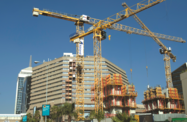South Africa’s construction sector appears to have been one of the big winners from the recently-released budget plan, following the ministry of finance’s announcement of a massive increase in spending on infrastructure and housing, although the industry will still need to overcome shortages of both human resources and materials as well as concerns over the government’s timely execution of capital projects.
In late October, Finance Minister Pravin Gordhan unveiled the government’s Medium-Term Budget Policy Statement (MTBPS), a mix of carrots and sticks to encourage the South African economy towards sustained growth while at the same time setting out plans to reduce costs in some areas and promote efficiency in the delivery of services by the state.
Central to the revitalisation of the national economy is the MTBPS’s commitment to boost spending on infrastructure, with the transport and logistics sector set to benefit from $29bn in investment, $4.9bn to be spent on the construction of hospitals and health facilities, and $4bn for education infrastructure over the next three years. The energy sector is also to receive $37.3bn in investment, though this spending to be divided among infrastructure, subsidies and incentives.
Along with the $15.1bn allocated by the state for local government for the financial year 2011-12, most of the funds will go directly to providing housing or infrastructure for communities, increasing the value of planned construction works to more than $90bn, local media reported.
This represents a major increase in public spending on infrastructure projects, with this current fiscal year’s outlays estimated at $27bn, representing 7.8% of GDP.
If the levels of capital investment are maintained, then the increased state spending should eventually translate into more employment and higher levels of consumer spending, which in turn should result in more work flowing into the industry from the private sector as demand for housing, retail and office space rises over the medium-term.
While it will take some time before the impact of the government’s accelerated infrastructure programme is felt, local construction giant Murray and Roberts has indicated that a corner has been turned.
“The South African construction economy is depressed, but there are early signs of a slow recovery in the local market and the medium-term outlook is positive given the major and growing infrastructural backlog in South Africa,” the group said in a statement issued on November 2.
Certainly the activity on the employment rolls seem to back this up. According to data issued by Statistics SA on November 1, the industry added 53,000 new jobs in the third quarter, second only to the financial sector and some 10,000 more than the mining sector – although this may be due in part to the significant downsizing of the sector in 2008
In spite of the dramatic increase in state-funded projects, however, there are a couple of obstacles that the sector will need to navigate. One of these is a shortage of skilled construction professionals, with the deficit of trained managers, engineers and tradespersons likely to hinder the roll out of some developments and fuel wage inflation.
In its infrastructure report card for 2011, the South African Institution of Civil Engineering warned that the country faced a severe shortfall in the number of construction professionals, saying that by proportion of population, South Africa had up to 20 times fewer engineers than Australia, the US, Western Europe, India and China. The study, issued earlier this year, also said that the current pool of engineers was ageing and did not represent South Africa’s demographic makeup, with the racial and gender balance overwhelmingly white and male.
“Increasing the number of engineers is a recognised government priority, but it will need a multifaceted approach starting with urgent attention to mathematics and physical science education at school,” the report said. “Training and mentorship of artisans and young engineering professionals is also essential at all levels, especially in the public sector.”
Another potential problem is a shortage of some vital building materials, with local media reporting that supplies of bitumen – essential for road construction – are insufficient to meet current work programmes, let alone the increase planned by the state. The scale of the schemes planned under the MTBPS will also jack up demand for products such as cement, timber and steel, with any shortfall having to be made up through imports.
Lastly, overall implementation and execution of large construction budget pronouncements has been a challenge for the government in past years. If the planned spending does come through in a timely fashion, however, and the construction industry can manage the flow of projects, and train the necessary additional workforce in time, it should be able to look forward to a busy and profitable few years.

